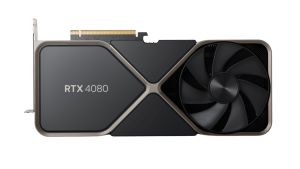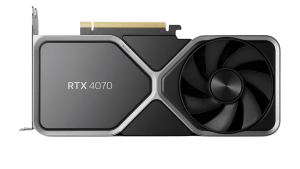The RTX 40 series has now been out for 8 months – oh how time flies! Starting with the first released card, the RTX 4090, we’ve now got a variety of cards to choose from this series. In this article, we’ll be looking at the cards in this series and what specs they have in store.
Nvidia RTX 4090
Real quick, before we get into the RTX 4090, I’d like to share an article we did a few months back on RTX 4090 Ti rumors so if you’re curious, take a look!
The RTX 4090 was launched on September 20th 2022 with a starting price of $1,599. It’s currently the highest performing card on the market, show a large increase of performance compared to the 3090ti. If you’re looking for the best of the best, this card is for you.

Clock Speeds
Base Clock: 2235 MHz
Boost Clock: 2520 MHz
Memory Clock: 1313 MHz, 21 Gbps effective
Memory
Memory Size: 24 GB
Memory Type: GDDR6X
Memory Bus: 384 bit
Bandwidth: 1008 GB/s
Slot Width: Triple-slot
Dimensions: 12″ L x 5.4″ W x 2.4″ H
TDP: 450 W
Suggested PSU: 850 W
Outputs: 1x HDMI 2.1, 3x DisplayPort 1.4a
Power Connectors: 1x 16-pin
Render Config
Shading Units: 16384
TMUs: 512
ROPs: 176
SM Count: 128
L1 Cache: 128 KB (per SM)
L2 Cache: 72 MB
Nvidia RTX 4080
The RTX 4080 was also released on September 20, 2022 with a launch price of $1,199. The RTX 4080 performs outstandingly, often coming in a few FPS short of the RX 4090. The gap in performance does widen when Ray Tracing is taken into account. It provides the best value for higher end cards.

Clock Speeds
Base Clock: 2205 MHz
Boost Clock: 2505 MHz
Memory Clock: 1400 MHz, 22.4 Gbps effective
Memory
Memory Size: 164 GB
Memory Type: GDDR6X
Memory Bus: 256 bit
Bandwidth: 716.8 GB/s
Slot Width: Triple-slot
Dimensions: 12.2″ L x 5.5″ W x 2.4″ H
TDP: 320 W
Suggested PSU: 700 W
Outputs: 1x HDMI 2.1, 3x DisplayPort 1.4a
Power Connectors: 1x 16-pin
Render Config
Shading Units: 9728
TMUs: 304
ROPs: 112
SM Count: 76
L1 Cache: 128 KB (per SM)
L2 Cache: 64 MB
Nvidia RTX 4070 Ti
Released on January 3rd 2023 with a launch price of $799, the RTX 4070 Ti is probably the best bang for your buck. Its FPS often hit triple digits and never dip below 60FPS.

Clock Speeds
Base Clock: 2310 MHz
Boost Clock: 2610 MHz
Memory Clock: 1313 MHz, 21 Gbps effective
Memory
Memory Size: 12 GB
Memory Type: GDDR6X
Memory Bus: 192 bit
Bandwidth: 504.2 GB/s
Slot Width: Dual-slot
Dimensions: 11.2″ L x 4.4″ W x 1.7″ H
TDP: 285 W
Suggested PSU: 600 W
Outputs: 1x HDMI 2.1, 3x DisplayPort 1.4a
Power Connectors: 1x 16-pin
Render Config
Shading Units: 7680
TMUs: 240
ROPs: 80
SM Count: 60
L1 Cache: 128 KB (per SM)
L2 Cache: 78 MB
Nvidia RTX 4070
The RTX 4070 launched on April 12 2023 with a price tag of $599. Advertised as reaching 100+ FPS at 1440p, this card does exactly that. The RTX 4070 does perform on average about 20% less than the RTX 4070 Ti, but it is a solid graphics card for those who don’t need the highest performing card on the market.

Clock Speeds
Base Clock: 1920 MHz
Boost Clock: 2475 MHz
Memory Clock: 1313 MHz, 21 Gbps effective
Memory
Memory Size: 12 GB
Memory Type: GDDR6X
Memory Bus: 192 bit
Bandwidth: 504.2 GB/s
Slot Width: Dual-slot
Dimensions: 9.4″ L x 4.3″ W x 1.6″ H
TDP: 200 W
Suggested PSU: 550 W
Outputs: 1x HDMI 2.1, 3x DisplayPort 1.4a
Power Connectors: 1x 16-pin
Render Config
Shading Units: 5888
TMUs: 184
ROPs: 64
SM Count: 46
L1 Cache: 128 KB (per SM)
L2 Cache: 36 MB
Nvidia RTX 4060
The RTX 4060 is not yet released so not all information is known and this information is subject to change in the future. It’s rumored to be set for release in early June with a price tag of $299.

Clock Speeds
Base Clock: 1830 MHz
Boost Clock: 2535 MHz
Memory Clock: 2250 MHz, 18 Gbps effective
Memory
Memory Size: 8 GB
Memory Type: GDDR6X
Memory Bus: 128 bit
Bandwidth: 288 GB/s
Slot Width: Dual-slot
Dimensions: Unknown
TDP: 200 W
Suggested PSU: 550 W
Outputs: 1x HDMI 2.1, 3x DisplayPort 1.4a
Power Connectors: 1x 12-pin
Render Config
Shading Units: 3840
TMUs: 120
ROPs: 48
SM Count: 30
L1 Cache: 128 KB (per SM)
L2 Cache: 24 MB
The RTX 40 series boasts a large increase in performance from the 30 series and is perfect for consumers who want top of the line performance. However, these cards, especially the RTX 4090, are not only physically large but consume a lot of power and are pricey. Many people have decided to skip the 40 series generation due to these issues, but there are also a lot of gamers who appreciate what the 40 series has to offer.




Recent Comments